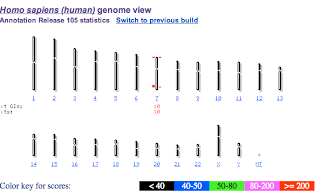The receptor we are studying in class is the TAS2R38 receptor which binds to the compound phenylthiocarbamide (PTC). Binding sends signals to the brain which are interpreted as bitter.
What happens if you can't make a working copy of the PTC receptor?
The PTC receptor is a membrane-bound protein made by a ribosome reading an mRNA.
The mRNA is transcribed from DNA found in the nucleus (and then processed).
Every cell in your body has the same DNA in its nucleus. The PTC gene is expressed (turned on) in tongue cells.
Here is the DNA sequence for the PTC gene:
1 cctttctgca ctgggtggca accaggtctt tagattagcc aactagagaa gagaagtaga 61 atagccaatt agagaagtga catcatgttg actctaactc gcatccgcac tgtgtcctat 121 gaagtcagga gtacatttct gttcatttca gtcctggagt ttgcagtggg gtttctgacc 181 aatgccttcg ttttcttggt gaatttttgg gatgtagtga agaggcaggc actgagcaac 241 agtgattgtg tgctgctgtg tctcagcatc agccggcttt tcctgcatgg actgctgttc 301 ctgagtgcta tccagcttac ccacttccag aagttgagtg aaccactgaa ccacagctac 361 caagccatca tcatgctatg gatgattgca aaccaagcca acctctggct tgctgcctgc 421 ctcagcctgc tttactgctc caagctcatc cgtttctctc acaccttcct gatctgcttg 481 gcaagctggg tctccaggaa gatctcccag atgctcctgg gtattattct ttgctcctgc 541 atctgcactg tcctctgtgt ttggtgcttt tttagcagac ctcacttcac agtcacaact 601 gtgctattca tgaataacaa tacaaggctc aactggcaga ttaaagatct caatttattt 661 tattcctttc tcttctgcta tctgtggtct gtgcctcctt tcctattgtt tctggtttct 721 tctgggatgc tgactgtctc cctgggaagg cacatgagga caatgaaggt ctataccaga 781 aactctcgtg accccagcct ggaggcccac attaaagccc tcaagtctct tgtctccttt 841 ttctgcttct ttgtgatatc atcctgtgtt gccttcatct ctgtgcccct actgattctg 901 tggcgcgaca aaataggggt gatggtttgt gttgggataa tggcagcttg tccctctggg 961 catgcagcca tcctgatctc aggcaatgcc aagttgagga gagctgtgat gaccattctg 1021 ctctgggctc agagcagcct gaaggtaaga gccgaccaca aggcagattc ccggacactg 1081 tgctgagaat ggacatgaaa tgagctcttc attaatacgc ctgtgagtct tcataaatat 1141 gcc
This DNA sequence is transcribed into an mRNA. The mRNA is read to create a protein. Here is the amino acid sequence of the protein that is a functional receptor. Note that each letter corresponds to one amino acid.
MLTLTRIRTVSYEVRSTFLFISVLEFAVGFLTNAFVFLVNFWDV
VKRQALSNSDCVLLCLSISRLFLHGLLFLSAIQLTHFQKLSEPLNHSYQAIIMLWMIA
NQANLWLAACLSLLYCSKLIRFSHTFLICLASWVSRKISQMLLGIILCSCICTVLCVW
CFFSRPHFTVTTVLFMNNNTRLNWQIKDLNLFYSFLFCYLWSVPPFLLFLVSSGMLTV
SLGRHMRTMKVYTRNSRDPSLEAHIKALKSLVSFFCFFVISSCVAFISVPLLILWRDK
IGVMVCVGIMAACPSGHAAILISGNAKLRRAVMTILLWAQSSLKVRADHKADSRTLC
Below are five mutations of a single nucleotides that produce non-functional PTC receptor proteins. I have highlighted these nucleotides in yellow in the DNA sequence above.
In your nucleus, you have 46 chromosomes in 23 pairs. One of each pair comes from your mother, the other from your father. The image below shows the 23 different chromosomes. The TAS2R38 gene is located on chromosome 7.
Let's imagine that you inherited a copy of functional TAS2R38 from mom as well as one from dad. We would call you homozygous for the taster allele. Would you be able to taste PTC?
Let's imagine that you inherited a mutated copy of TAS2R38 from both your mother and your father. We would say you were homozygous for the nontaster allele. Would you be able to taste PTC?
Now, let's imagine you were heterozygous. You got one functional copy from one parent, but a nonfunctional copy from the other. Would you be able to taste PTC?
You probably already know about dominant and recessive alleles. Dominant alleles are said to "mask" the presence of recessive alleles. Hopefully, you answered that heterozygotes can taste PTC (they have the taster phenotype). That would make the taster allele dominant.
So, the dominant allele is due to a functional copy of a protein, while the recessive allele is a nonfunctional copy. This is usually the case for genes that show traditional Mendelian dominant/recessive relationships.
Here is a good video from Howard Hughes Medical Institute on PTC:





No comments:
Post a Comment